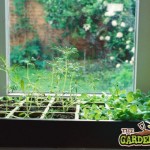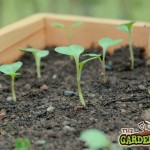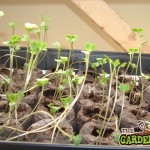With the extended winter that we are experiencing and the cold nights set to last for another week there has been a gradual build up of garden trays, plant pots and propagators eagerly awaiting better light conditions in which to grow. If you are like me and you’ve already been busy potting up this summer’s crops then you are very possibly running out of places to put them all.
- growing on a window sill
- Cabbage Seedlings
- Cabbage seedlings lacking light
I always stress that for successful growing you need to have the right setup. By that I mean that you have a way to keep all your garden trays and young potted plants until they are ready to be transplanted out into the vegetable garden.
The right set up allows for ease of storing your trays and pots, it should allow for ease of watering, feeding, moving, turning and viewing your crops. The right set up should have suitable light conditions, suitable temperatures and enough space to grow everything you need.
An example of the right set up would be to have your seed trays, plant pots and propagation trays sitting on garden trays. Capillary matting beneath the trays and pots allows for even watering. Location is a critical factor in having the right set up. You will need a small greenhouse situated indoors, in your kitchen or porch or conservatory. I find a south facing bay window gives a great amount of light. You would also need a small polytunnels or greenhouse outdoors where seedlings can be moved once the frost has passed. Finally a vegetable patch is needed where your plants will mature. Light conditions are very important as we generally begin sowing our seeds in mid February and they should have germinated by late February. Light conditions in late February are too low for good seedling growth and therefore it is essential that you give them the most amount of light they can receive.
With this in mind position your garden trays in your mini greenhouse indoors next to a south facing window. The window needs to be large and should not be tinted or frosted as both reduce light levels. The mini greenhouse itself can also reduce light levels reaching the seedlings if the polythene is old or dirty.
If your seedlings don’t receive enough light they will grow tall and thin, the seedlings will eventually fall over as they become top-heavy. This can cause their stems to bend which eventually kills the seedling. Seedlings that have fallen over are also at risk of dying from rot and fungal diseases.
If your garden trays, pots and seed trays are suitably located with ample light your seedlings will grow shorter stems and develop their true leaves faster. This will give stronger, healthier plants that are easier to handle and transplant, prick out or pot on.
At this point my indoor greenhouse in my south facing bay window is full. All my seed trays are full with young leeks, cabbage, lettuce, broccoli, radish, cauliflower and other seedlings. I have had to position my mini propagators with sweet corn, tomato, cucumber and aubergines on the window sills of my living room as space will be at a premium until the spring decides to start. At that point I can hard off all these seedlings in my outdoor greenhouse and begin transplanting my cabbage, lettuce and other directly into the vegetable plot.


